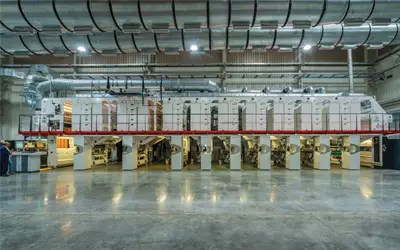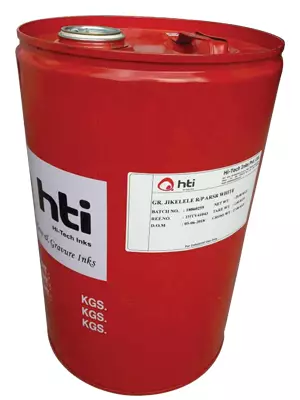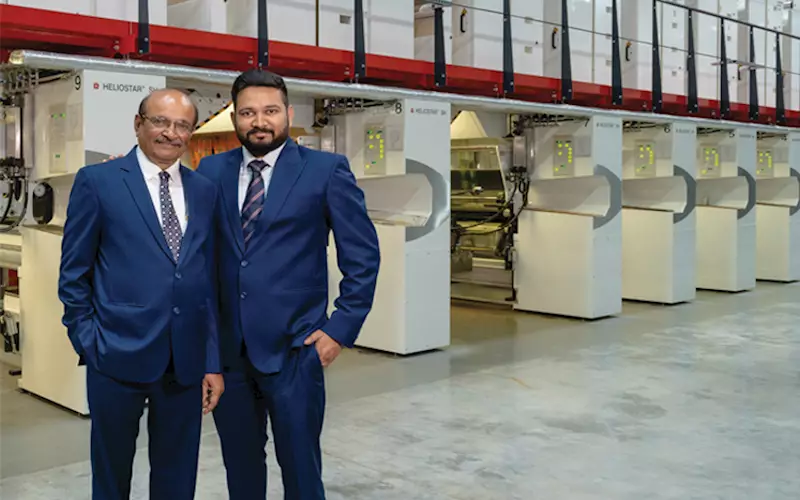Balaji Multiflex: Rs 120-crore flexible packaging factory
A dream project and a relentless two-year pursuit in setting up the 2,50,000 sqft greenfield factory at Amreli in Rajkot, has made Balaji Multiflex one of the most-modern and sophisticated flexible packaging plants in the country, says Rushikesh Aravkar
24 Oct 2018 | By Rushikesh Aravkar
It’s a truly breathtaking sight to see Balaji Multiflex’s sprawling flexible packaging factory that deploys modern sensible technology in gravure printing and converting, a tidy shopfloor and delivers consistency in quality and delivery of flexible food packaging material.
In its 16th year of operations, the Rajkot-based flexible packaging company Balaji Multiflex has made some bold investments to set up this new factory that spreads over 20 acres of land. Today, the cornerstone of the factory is a highly-configured (W&H) Windmoller and Holscher Heliostar II rotogravure press, an India first. Plus the company has backwards integrated with a new Varex three-layer blown film line. Two Nordmeccanica solventless laminators join the converting arsenal. The remaining eight laminators - six Nordmeccanica, two Comexi, and two Pelican – currently installed at the old plant will soon be shifted to the new facility.

India’s first brand new W&H Heliostar II rotogravure printing machine
The new W&H Heliostar II at Multiflex is a nine-colour rotogravure press. Even though this is India’s first brand new W&H rotogravure printing machine, the configuration is top-end. Two prominent specs: it is a 1400mm wide machine and it boasts a maximum printing speed of 500 metres per minute.
Advantage W&H
Heliostar II S rotogravure printing press
- Procontrol with Vision system: The entire machine is controlled centrally through Procontrol. The fully integrated Vision system enables exhaustive and real-time monitoring of job works and process flow.
- Easy-Sync: It enables easy and quick pre-register setting.
- Heliocontrol: The register control system maintains register accuracy at high-speed.
- Advanced drying system and web-guide system for superior quality printing.
- Turboclean G: The ink supply a wash-up system supports fast, effective and energy-saving job changeovers.
When WhatPackaging? team visited the factory, during the Image-to-Print roadshow, the machine printed a seven-colour print job on a 15-micron BOPP film. Running at 82 metres per minute in the beginning, the machine speed was ramped up to 500 metres per minute within a few seconds and the camera-based auto registration system indicated zero loss of registration. That is impressive. Noteworthy is that the machine is extremely quiet even while operating at such a high-speed.
This is Balaji’s second plant. Eventually, all the operations from its first plant, which is located a few kilometres away, will be accommodated at the new site in order to streamline operations and bring “everything under one roof”.
“By 2020, we plan to have four rotogravure printing machines. This includes one of our existing Pelican machines and the new W&H Heliostar. Plus we have ordered one Pelican-Cerutti machine, which will be commissioned soon. We are also contemplating to opt for another W&H rotogravure press. That will make two W&H and two Pelican machines. Besides this we have additional space for two more printing machines,” informs Pranav Bhalara who helms Balaji Multiflex along with his father Chandrakant.
Good practices
Balaji Multiflex was established by Bhalara's father in 2002 with a specific objective of producing multi-layer flexible packaging material for his brother-in-law Chandubhai Virani’s namkeen brand Balaji Wafers. Sr Bhalara, a commerce graduate, who managed a small anodising business, was keen on trying his hand at something new and challenging. Virani on knowing Bhalara’s intent and enthusiasm advised him to set up gravure printing operations and guided him to equipment manufacturer Pelican Rotoflex. Thus with a mechanical line shaft gravure press, a solvent-based laminator, and a slitting machine, Balaji Multiflex made modest beginnings producing six tonnes of packaging material every month.
Over the years, as Balaji Wafers grew, the packaging converter continued to add capacity. In 2007, the junior Bhalara, after completing his hotel management degree from Switzerland, returned to India to join the family business. His first project was to set up a canteen facility for his employees. “They are my team. It’s important for me to take care of my people. I set up a canteen that serves wholesome food for my employees,” says Bhalara.
His next project was to set up an R&D laboratory. “Very few converters realise the importance of research and development. How else will you be ahead of the pack? We have invested around Rs 2.5-crore to set up an R&D lab where we do a lot of shelf life studies plus WVTR (water vapour transmission rate) and OTR (oxygen transmission rate) studies.”
Slowly and steadily as Bhalara started overseeing individual departments in the company, he started fixing gaps and streamlining processes. For example, the ink department. Bhalara explains, “I realised that we were using inks from three different suppliers in producing one single job. It’s a problem. In case there’s an issue which supplier do you turn to? We worked on our ink management in such a way that we appointed one dedicated supplier for each machine.”
During this process, Bhalara met Karan Mahajan of Hi-Tech Inks, who introduced him to non-toluene non-ketone (NTNK) ink. “This is an expensive ink, however, Mahajan suggested that if we reduced the ink grammage we can reduce the ink consumption. But more than that, we realised the harmful effects of toluene and ketone on the shopfloor workers. We thought, for the better health of my people and the people who use my products, it makes sense to spend extra than use harmful carcinogenic materials. Both Hi-Tech and Flint helped me switch to NTNK inks."
Understanding NTNK ink systems: Karan Mahajan, Hi-Tech Inks
Balaji Multiflex and Hi-Tech Inks have been associated since the past five years. We used to supply the conventional vinyl inks. It was Pranav Bhalara’s vision to set up a modern facility and use advanced technologies. He entrusted Hi-Tech to start the shift from the conventional toluene-ketone inks to the non-toluene non-ketone (NTNK) ink system. Today we are the major supplier of NTNK inks at Balaji Multiflex.
Toluene-free has been an industry buzzword for quite some time. The question is whether or not it has been successfully implemented. However, one must understand that being toluene-free is the start and not the end. A packaging material needs to encompass overall safety mechanisms at all levels and ingredients of the packaging material. There is quite an exhaustive list of substances that are harmful including a large list of pigments, resins and additives. Even on the solvent side, there are solvents like Benzene and Xylene that are probably worst in nature than toluene.

Ketones as a solvent are not the easiest to remove from the laminate and thus risks having higher solvent retention levels. Besides, with more and more converters going for both gravure and flexo printing presses, it gives the ink company and the converter an opportunity to work with a single ink system (with suitable solvents) on both presses. One also needs to keep in mind that Ketones too have their own share of health hazards like dizziness, dermatitis, and nausea.
We have ensured that our NTNK ink systems are completely free of hazardous raw material inputs. We are affiliated with a laboratory wherein we send all samples for a thorough analysis before launching them into the market and test them based on the Swiss ordinance and EU regulatory norms.
I think the industry needs to be self/ethically responsible for delivering safe products with safe ingredients rather than waiting for government regulations and/or fiascos to happen in the industry. A continuous dialogue needs to be developed for updating the authorities and brand owners on such initiatives for the benefit the society at large.
Since 2015, Balaji Multiflex has been using NTNK inks. “Today, regulatory bodies are contemplating ban on toluene in inks for food packaging. However, we have been using NTNK inks for last one and a half years. Even ketones are carcinogenic. We supply to food companies. They don’t ask for it but when we know something is harmful it is in best interest of everyone to use what’s safe. Therefore we shifted to NTNK inks.”
During the visit, one realises the conscious efforts towards cleanliness and hygiene and the company’s vision of sustainability. Balaji Multiflex was also the first Indian flexible packaging converter to invest in a solventless lamination machine from Comexi in 2003.
Next on Bhalara’s green agenda is a solvent recovery plant. All the exhausts at the new plant meet at a one-point exit, which will connect to the solvent recovery plant. “As flexible packaging converters, we spend crores of rupees on solvents every year. A one-time investment in solvent recovery plant will not only help me reuse the recovered solvent but also reduce my operating cost and up my sustainability quotient,” says Bhalara.
“With a solvent recovery plant in mind, we wanted to go for mono solvent inks. But it’s too early for that. Working with mono solvent inks is difficult. So we started with NTNK but in future will develop capabilities for printing with mono solvent inks.”
Bhalara points out that till date Balaji Wafers has not downgauged their packaging material below 50 microns. The reason, he says, is stronger packs signifies better product, however, more importantly, thicker packs create value for ragpickers and in a way enables circular economy.
A dream project
Balaji Multiflex has spent Rs 120-crore to set up this greenfield project.
Bhalara says, “It’s a dream project. We wanted to improve our quality quotient so much so that when people think of good quality flexible packaging, they should turn to us. We wanted to be a lighthouse to the Indian flexible packaging industry.”
He adds, “The general idea of a converting plant in India is a messy, dusty shopfloor. We wanted to defy this assumption. I believe we have been pretty successful.”
Bhalara claims that the new W&H Heliostar is India’s first 1.4-metre wide gravure machine. He opted for this width despite experts suggesting that the best gravure presses are the ones which are one-metre wide. The rationale behind this, according to Bhalara, has to do with run lengths getting shorter and the pack sizes getting smaller.
“That’s the trend in India. The moment the pack size reduces, and you have a wider machine, you will be able to accommodate an additional number of ups,” explains Bhalara.
“The reason we chose W&H is because the company has a rich experience in building wide-web machines. In a one-metre wide machine, generally, we can accommodate three ups. In 1.4-metre wide machine, we will be able to print at least five ups. While the cost of cylinders will increase slightly, with wider machine, in the same operating cost and energy spent, we can print about 30% extra.”
“Moreover, the new W&H deploys shaftless cylinders. When you use a shaftless machine, you can build heavy cylinders, which allows you to print additional ups along the circumference. So, for jobs where we were printing two ups, we can now print three ups. Again I’m getting 25% extra. So that’s 55% extra. And at the same time, this machine can print at 500 metres per minute as opposed to Indian-made machines which can print at a maximum speed of 400 metres per minute. So that’s again 25% additional production. So as compared to my competition with an Indian-made machine, I have already got 80% extra.”
The shaftless cylinders also help with the quick changeover.
Bhalara understands wastage is the biggest deterrent in a converting business. If you control wastage, everything else is under control, he says.
This is also the reason why the company has integrated backwards to add a 2.8-metre wide W&H Varex line. This width can accommodate twice the width of the printing machine.

Pranav Bhalara with his cousin Nirav Bhalara. Nirav oversees W&H Varex blown film line
“The three-layer Varex line helps us with the third layer. It’s a food-grade layer. This layer is crucial as it is also the sealing layer. We were facing a lot of challenges from the outsourced vendors. When the price of the granules escalated, they used to change the raw materials and the quality of the film used to get hampered. So we decided to go for an in-house blown film extrusion line,” says Bhalara.
Advantage W&H
Varex II blown film line
- Precisely metered resin feed for consistent product quality and material saving
- Versatile die for wider-range of layer thickness distribution and short changeovers.
- High-output air ring for better bubble stability, effective film cooling and high throughputs.
- Comfortable, intuitive operation through an integration of W&H automation modules including Easychange, Easywind, Profile Booster, Turboclean and Purgeassist.
He adds, “The biggest cost in running a blown film line is the raw material which constitutes 80% of the cost. If we save at least five per cent of raw material in the long term, then it gives us an edge.”
Not only with the performance, but Bhalara is impressed also with the looks and design of the Varex line. “The Heliostar was my dream but my love was Varex. More than engineering, the machine design is remarkable,” he adds.
Today, Balaji Wafers is one of the significant players in the branded snacks market. As reported by The Economic Times, in 2017 (till September) Balaji Wafers clocked sales of Rs 2,121-crore becoming the second-largest in terms of individual brands in the segment. Balaji Multiflex, which is the largest supplier of flexible packaging material to Balaji Wafers has followed suit. From six tonnes per month in 2002, the packaging converter today produces 35 tonnes of packaging material every day.











 See All
See All